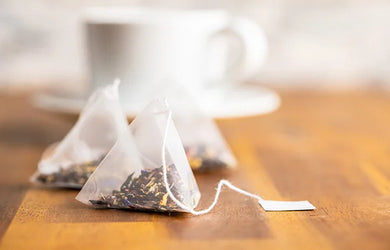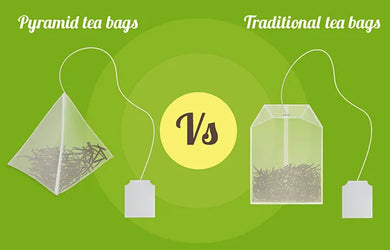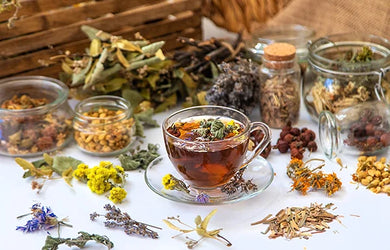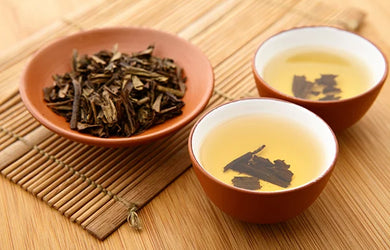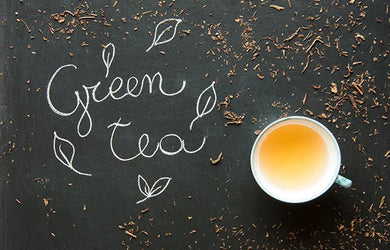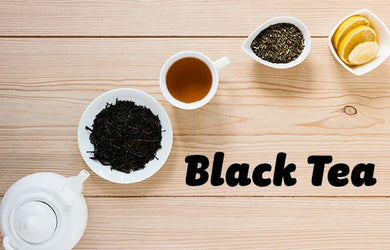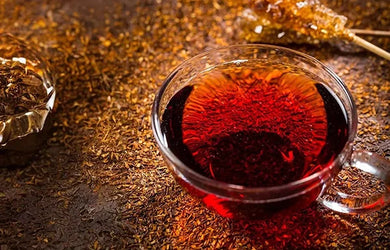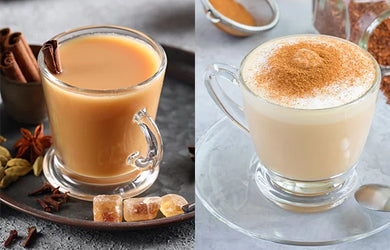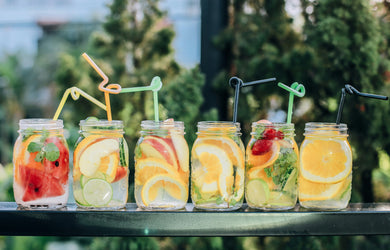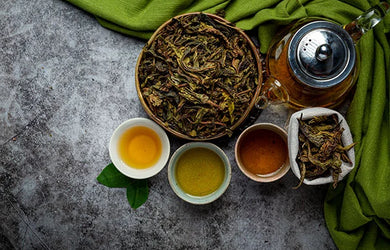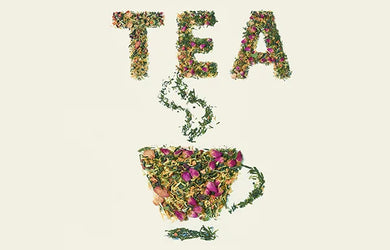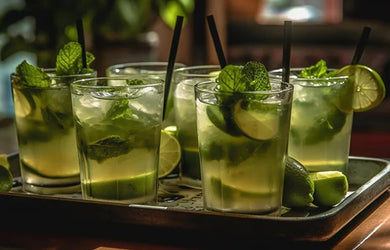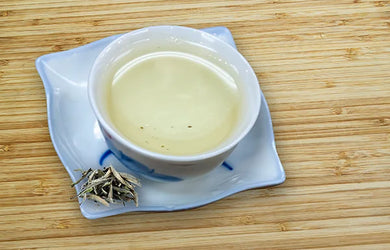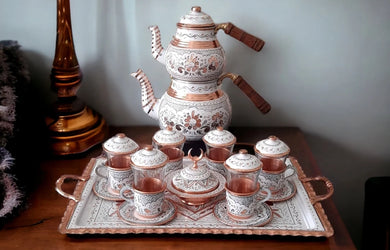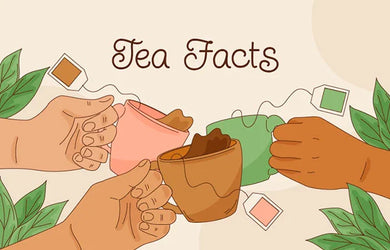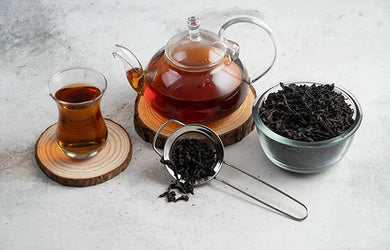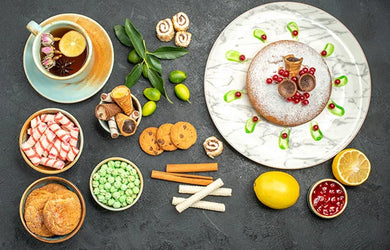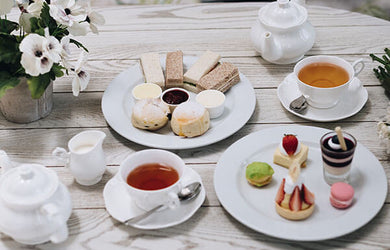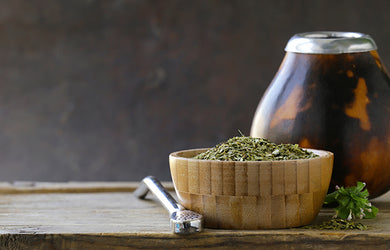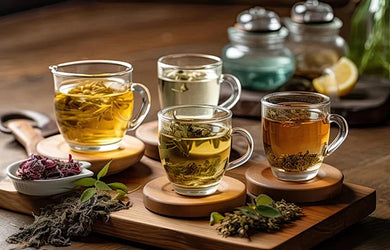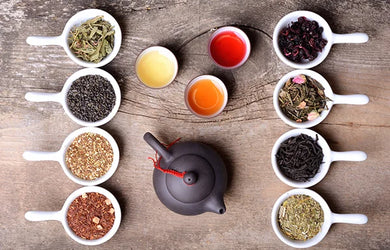In the history of humankind, tea has been enjoyed for thousands of years, spanning various cultures and countries. This does not surprise us. Tea is a rather simple beverage — whipped up by soaking dried leaves in hot water to create a delicious warm beverage.
However, tea can refer to many different flavours, with over 3000 tea types. Tea typically falls into several types of teas, including green tea, black tea, white tea, oolong tea, herbal tea, and other tea types like yerba mate.
The popularity of tea throughout the world is undeniable. After water, tea is the most popular beverage in the world. So, we wanted to create a guide for this popular little beverage and walk you through your options when it comes to a steamy mug of goodness to begin or end your day.
But before we jump into all the different tea varieties — where do all teas types originate from?

tea plant camellia sinensis: source of different types of teas
All types of teas come from one place — the Camellia Sinensis plant. The camellia sinensis is the plant from which all 'true' tea types of teas originate. It's an evergreen plant that can grow as tall as sixty feet in the wild. However, when grown with the intent of harvest, camellia sinensis bushes are typically only grown to about three feet. This plant originated thousands of years ago in southern China.
The leaves of Camellia sinensis are used to make up all of the crowd-favourites when it comes to types of teas, including black tea, green tea, oolong tea and white tea. Which tea types are made from the plant will depend upon the specific plant variety of Camellia sinensis and its growing environment and processing method. Tea types that don't contain Camellia sinensis aren't actually tea - but because most people consider them herbal teas, they tend to be thought of as different types of teas.
There are two main varieties of Camellia sinensis:
Camellia sinensis var. sinensis — This plant grows primarily in China and other East Asian countries. Tea types made from this plant tend to have a mild and mellow flavour.
Camellia sinensis var. assamica — Of the tea variety this one grows primarily in India. Types of teas made from this plant tend to have a stronger flavour.
green tea
Green tea is undoubtedly one of the most popular types of tea. While it comes from the same Camellia Sinensis plant that produces other traditional tea varieties, its uniqueness lies in its non-oxidised leaves. Even though all of these teas are made from unoxidised leaves, regional cultivation has given rise to different tea varieties.
mao feng green tea:
Mao Feng is a premium Chinese tea known for its young and tender tea buds, carefully handpicked in spring. The leaves resemble pine needles and unfurl beautifully when brewed.
Mao Feng offers a light, refreshing taste with floral and fruity notes and subtle sweetness. This pale green tisane is smooth, low in bitterness and rich in antioxidants.
Just like there are several green types of tea, several Mao Feng tea types are also available. The most famous ones come from the Yellow Mountain in Anhui province, but you can also find these tea types in other parts of China, like Yunnan, Fujian and Zhejiang, and even in other countries.
green mint tea:
Green mint tea isn’t exactly one of the cultivated types of tea – it’s a cool blend of unoxidised tea leaves and peppermint leaves. Any of the different types of teas (the green ones, of course!) can be used, with Chun Mei being one of the popular choices. Chun Mei (also called “Precious Eyebrows” due to the shape of its leaves) has a subtle fruity sweetness that goes very well with the cooling properties of the mint.
When you infuse the blend in water it produces a golden tisane that not only has an outstanding taste but several health benefits as well.
black tea
Among all the types of tea available, black tea is the most consumed globally. It’s also probably the most recognisable by its dark, oxidised leaves. The oxidation simply means that the leaves are dried in the air – the process makes the leaves darker and stronger in flavour. That change makes it suitable to be enjoyed with or without milk.
everyday brew tea bags:
These tea bags are packed with a blend of outstanding types of tea from Assam, Ceylon and Rwanda. The tea leaves used (especially in teapigs tea temples) undergo a careful selection process to ensure consistent quality and taste. With those tea varieties in place, they are a great way to enjoy a wonderful cup of classic black tea every day.
One of the key features of this brew is its strong flavour. The tea leaves are carefully blended to create a bold taste that goes well with or without milk and sugar. It’s a popular choice for those who prefer a no-frills black tea with a comforting flavour.
darjeeling earl grey tea bags
Darjeeling Earl Grey tea is a citrusy-flavoured brew made by combining Darjeeling black tea with bergamot oil. There’s one crucial consideration while plucking the leaves for the tea – there should be two leaves and a bud. They are carefully selected to ensure a high-quality infusion.
The addition of bergamot oil, extracted from the rind of the bergamot orange, improves the traditional tea experience. This citrus fruit adds a refreshing fragrance and subtle sweetness that balances the strong taste of well-oxidised black leaves.
These wonderful ingredients of the highest quality are combined and packed in spacious teapigs’ tea bags for convenience and rich taste.
english breakfast tea bags
English Breakfast tea is one of the most classic tea that’s enjoyed by tea drinkers globally. No surprises there – it has a strong and full-bodied flavour. This black tea blend is designed to be the perfect addition to a lovely breakfast – providing an outstanding start to the day.
The tea leaves used in teapigs tea bags are carefully sourced from some of the best estates in India, Rwanda and Sri Lanka. These leaves undergo a thorough oxidation process for that distinctive dark colour and powerful taste. When the tea bags are steeped in water, you get a tea that is both bright and malty.
chai tea bags
Chai tea (or just "chai") is almost always made with black tea, milk and an array of spices. This combination creates a rich and warming drink that’s really popular in some cultures – especially in India. There are many regional variations of chai tea across India, each with its own twist.
It’s an outstanding tea but getting the spices right can be tricky. Teapigs tea bags take care of that by using outstanding spices and black so you can enjoy this tea without any hassles. Just dip the tea bags in water, add milk and sweetener – that’s it, your chai tea is ready to be enjoyed.
white tea
White tea is one of the most delicate types of tea because it’s made from minimally processed tender leaves and buds of the tea plant. The youngest leaves and buds are harvested while they are still covered in fine white hair. The white tea gets its aroma and name from these fine hairs.
silver needle
This white tea, also known as Bai Hao Yin Zhen, is one of the highest-grade types of tea. It’s made from only the tender buds of the tea plant, giving the tea a light yet complex flavour. Originally, this tea was grown in the Fujian mountains of China, but similar styles are now produced in other countries.
The flavour of white tea from different regions differs, and ranges from delicate floral and fruity to grassy or herbal. The texture ranges from crisp and refreshing to creamy and smooth. These flavours and textures make it a delightful drink, and with its caffeine and theanine content, it’s both energising and enjoyable.
white peony
Also known as Bai Mu Dan, this white tea is grown in the Zhenghe and Fujian regions. Unlike other types of tea from the Camellia Sinensis plant, White peony is made from the plant’s two young leaves and one tender bud. The leaves are not fully open when they’re plucked and its name comes from how the leaves open up in water, resembling blooming white peonies.
As the second highest-quality white tea, it offers a mild and smooth flavour with fruity notes and a touch of green tea-like freshness. Its sweet taste can be enhanced with lemon or honey.
shou mei
Also known as "Old Man's Eyebrow", this white tea is one of the most distinctive types of tea. Shou Mei gets its name from the large, crescent-shaped leaves that are very different from other white tea varieties.
This unique tea is grown in the remote mountains of the Fujian region in China where it’s collected later in the season – after silver needle and white peony. Since it uses only a few buds and 2-3 leaves this tea is considered a low-grade white tea, making it a more affordable option without losing out on quality. Additionally, as a compressed cake tea, it can be aged to develop a sweeter flavour.
oolong tea
Oolong tea is one of the unique types of tea made by partially oxidising the tea leaves (exposing them to air). The oxidation levels can range from 7 to 70 per cent – it increases with increased exposure to air. The amount of time they're exposed to air affects the flavour and colour. So, its taste varies from light and flowery to strong and smoky, and the colour can be anything from green to dark brown.
matcha tea
Matcha is a special kind of green tea that’s been part of the Japanese tea ceremonies for a very long time. Unlike other types of tea, where you steep the leaves and then strain them, matcha is made by grinding the whole tea leaf into a fine powder. The powder is then combined with hot water to produce a frothy beverage. This process creates a concentrated flavour and lively green colour.
yellow tea
Yellow tea is one of the rarest types of tea that falls between green and white tea in terms of oxidation. Many consider it similar to green tea, however, yellow tea goes through an additional step where the leaves are steamed for longer, then wrapped and allowed to ferment slightly. This process gives the tea its yellow colour and makes it different from other types of tea. It also gives it a sweet and mellow flavour.
purple tea
Purple tea is made from one of the unique types of tea plant – a variety of the Camellia Sinensis plant, mostly grown in Kenya. Its leaves are purple due to a natural change in its genes. This change also gives them lots of antioxidants called anthocyanins. In fact, purple tea has about 15 times more of these antioxidants than blueberries! When brewed, this tea has a sweet, earthy taste and a nice colour.
pu-erh tea
Pu-erh tea is a uniquely processed tea that gets its name from a place called Pu’er in China. Made from one of the large-leaf types of tea plant, Pu-erh tea undergoes a special fermentation process after drying, which deepens its flavour over time. It gives Pu-erh tea a rich and earthy flavour and makes it age more dynamically than other types of tea. That’s why it’s often regarded as a wise investment choice.
herbal tea
Herbal tea isn’t one of the traditional types of tea, but it’s called “tea” since it’s brewed similarly. Technically correct terms are herbal infusion or tisane. These herbal infusions are made from herbs, spices, flowers, fruits or other parts of a plant. There are many different herbal tea types and almost all are caffeine-free.
rooibos
Rooibos tea, also called red bush tea, is made from a red-coloured bush native to South Africa's Cederberg Mountains.
These plants are harvested by hand and bundled together. The bundles are cut or bruised to help them change colour and taste. This oxidation process creates two rooibos tea types – red and green. The more oxidised the rooibos, the redder and sweeter it becomes, earning the name red rooibos. However, if rooibos is steamed and dried right away instead of oxidising it stays green and has a grassy and earthy taste. This type of rooibos is called green rooibos.
chamomile
Chamomile tea is made from the flowers of the chamomile plant – particularly from two main varieties – German chamomile and Roman chamomile. The German variant has a larger, white flower with a prominent, cone-shaped yellow centre while the Roman variant has a smaller, white flower with a central yellow disc.
The tea made from these flowers is one of the most soothing types of tea. This soothing tea has a subtle fruity taste – something like an apple. That’s where its name comes from. It comes from the Greek words "khamaimelon", where "khamai" means "on the ground" and "melon" means "apple".
peppermint
Peppermint tea is made by steeping the fresh or dried leaves of the peppermint plant in hot water. It’s a popular aromatic herbal infusion that has a strong minty fragrance and flavour. This caffeine-free drink can be refreshing on a hot day or wonderfully warming on a cold day.
Peppermint leaves are rich in beneficial oils which create that refreshing taste. One such oil is menthol which is responsible for that cooling sensation and potential health benefits. That’s why peppermint has been used for medicinal purposes for centuries. In fact, dried peppermint has been discovered in Egyptian pyramids dating as far back as 1000 BCE, indicating its historical use.
hibiscus
Among the other types of tea, hibiscus tea is one of the most visually appealing. It’s hard not to get drawn towards this deep red coloured drink made from the petals of the hibiscus flowers. But there’s more to this drink – it’s equally refreshing and has a tart and fruity flavour. It tastes a bit like cranberry juice.
Its visual appeal, taste and potential health benefits have made this African native popular globally. It’s especially refreshing in warmer weather when served chilled. Additionally, its lively red colour and tangy taste make it a popular choice for cocktails, especially during warmer months.
yerba mate tea
Yerba mate is a popular South American tea made from the dried leaves and stems of a yerba mate tree. It’s a member of the holly family and produces evergreen leaves with small, greenish-white flowers that ripen into berries. Its leaves and stems are harvested, dried and sometimes roasted over wood. These ingredients are used with water to make caffeinated yerba mate tea – an unusual attribute for an herbal infusion. It’s unlike different types of teas in this category.
conclusion
So that's the end of our overview of different types of tea which includes some of the most delicious drinks on the planet. We've explored lesser-known varieties like yellow tea and purple tea and probed into some of the most interesting herbal tea types that offer caffeine-free alternatives, as well as those that have caffeine content.
While we've explored many of the most popular tea types, there are many more for you to discover. So, continue exploring and enjoying the natural drinks provided by nature.
faqs on different types of teas
Q. what are the six types of teas?
A. the six main types of tea are those derived from camellia sinensis. they are – black tea, white tea, green tea, oolong tea, pu-erh tea and yellow tea. while there are other tea types that are very popular and beneficial, they fall in the category of herbal infusions and not traditional tea.
Q. what are the 10 varieties of tea?
A. the 10 tea varieties represent different styles within the traditional tea categories.
1. black tea: english breakfast, darjeeling earl grey and every day brew
2. green tea: mao feng tea, green mint tea and matcha green tea
3. white tea: silver needle and white peony
4. oolong tea: tieguanyin and da hong pao
Q. what are the 5 types of tea?
A. all teas can be categorised by oxidation levels into five main types. white tea is the least oxidised, green tea is not oxidised at all, oolong is partially oxidised, black tea is fully oxidised and finally, pu-erh tea is post-fermented, allowing the tea to oxidise and age over time.
Q. what are the top 10 best teas to drink?
A. the best tea depends on personal choice, but popular choices include green tea, black tea, oolong tea, white tea and pu-erh tea for their flavour and potential health benefits. herbal favourites include chamomile, peppermint, hibiscus, ginger and rooibos which are preferred for being caffeine-free options with unique flavours and potential health benefits.
popular blogs
benefits of black tea | green tea benefits | herbal tea benefits | benefits of peppermint tea | benefits of chamomile tea | benefits of rooibos tea | benefits of raspberry leaf tea | benefits of oolong tea










